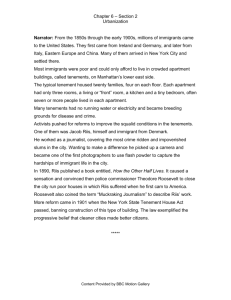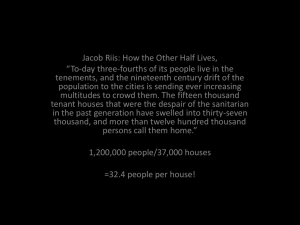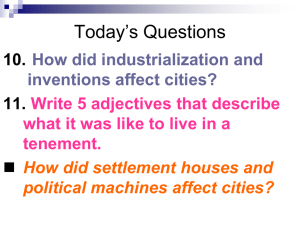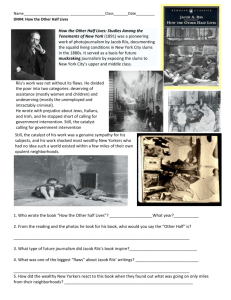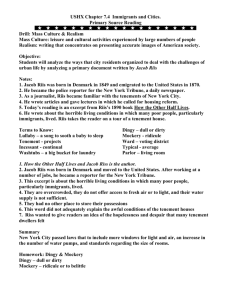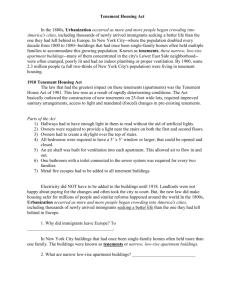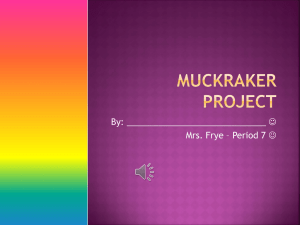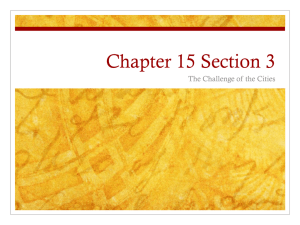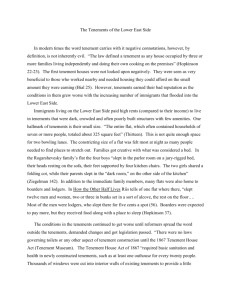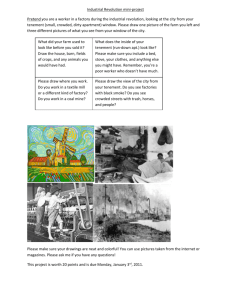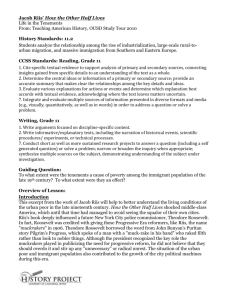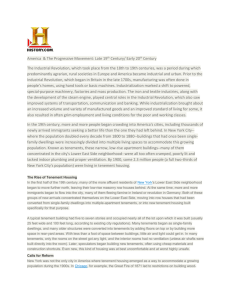During the 1880s many in upper- and middle
advertisement
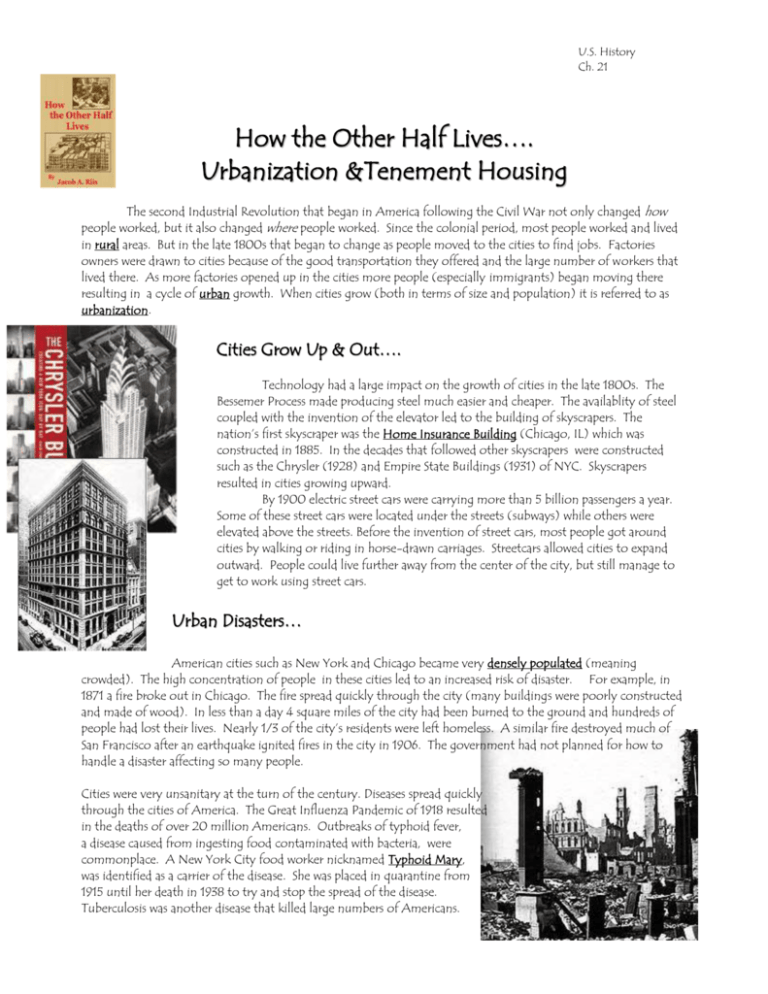
U.S. History Ch. 21 How the Other Half Lives…. Urbanization &Tenement Housing The second Industrial Revolution that began in America following the Civil War not only changed how people worked, but it also changed where people worked. Since the colonial period, most people worked and lived in rural areas. But in the late 1800s that began to change as people moved to the cities to find jobs. Factories owners were drawn to cities because of the good transportation they offered and the large number of workers that lived there. As more factories opened up in the cities more people (especially immigrants) began moving there resulting in a cycle of urban growth. When cities grow (both in terms of size and population) it is referred to as urbanization. Cities Grow Up & Out…. Technology had a large impact on the growth of cities in the late 1800s. The Bessemer Process made producing steel much easier and cheaper. The availablity of steel coupled with the invention of the elevator led to the building of skyscrapers. The nation’s first skyscraper was the Home Insurance Building (Chicago, IL) which was constructed in 1885. In the decades that followed other skyscrapers were constructed such as the Chrysler (1928) and Empire State Buildings (1931) of NYC. Skyscrapers resulted in cities growing upward. By 1900 electric street cars were carrying more than 5 billion passengers a year. Some of these street cars were located under the streets (subways) while others were elevated above the streets. Before the invention of street cars, most people got around cities by walking or riding in horse-drawn carriages. Streetcars allowed cities to expand outward. People could live further away from the center of the city, but still manage to get to work using street cars. Urban Disasters… American cities such as New York and Chicago became very densely populated (meaning crowded). The high concentration of people in these cities led to an increased risk of disaster. For example, in 1871 a fire broke out in Chicago. The fire spread quickly through the city (many buildings were poorly constructed and made of wood). In less than a day 4 square miles of the city had been burned to the ground and hundreds of people had lost their lives. Nearly 1/3 of the city’s residents were left homeless. A similar fire destroyed much of San Francisco after an earthquake ignited fires in the city in 1906. The government had not planned for how to handle a disaster affecting so many people. Cities were very unsanitary at the turn of the century. Diseases spread quickly through the cities of America. The Great Influenza Pandemic of 1918 resulted in the deaths of over 20 million Americans. Outbreaks of typhoid fever, a disease caused from ingesting food contaminated with bacteria, were commonplace. A New York City food worker nicknamed Typhoid Mary, was identified as a carrier of the disease. She was placed in quarantine from 1915 until her death in 1938 to try and stop the spread of the disease. Tuberculosis was another disease that killed large numbers of Americans. Tenenment Housing… Most families living in cities could not afford to buy homes, so they rented apartments or tenements. A tenement is an apartment house that is run-down and overcrowded. Old buildings, landlord neglect, poor design and little government control led to dangerous conditions in many tenements. Poor families that could not afford to rent a place of their own often needed to move in with other families. This resulted in severely overcrowded tenements. It was not uncommon for 12 or more people to live together in a two-room apartment. Inadequate garbage pick up also caused problems. Tenants dumped their garbage down narrow air shafts between the apartment buildings. There was little fresh air and the smell was awful. The garbage attracted rats and other pests that quickened the spread of disease. Most tenements had no running water. Residents had to collect water from a faucet in the street. The water had to be heated for bathing, but it was unsafe to drink. In the first week of July in 1877, 139 babies died in the city of Baltimore from drinking contaminated water. Few tenement buildings had indoor plumbing. Sewage flowed in open gutters. Neighborhoods full of these tenement buildings became known as slums. After visting the slums of Chicago, British writer Rudyard Kipling wrote, “Having seen Chicago, I urgently desire to never see it again.” During the 1880s many in upper- and middle-class society were unaware of the dangerous conditions in the tenement houses. Jacob Riis, an immigrant himself who could not originally find work, hoped to expose the poor living condtions that existed in the slums of New York City. After a successful career as a police reporter he decided to publish a photojournal documenting these conditions using graphic descriptions, sketches, photographs, and statistics. Riis blamed the apathy of the rich for the conditions of the New York slums, and assumed that as people were made more aware of these conditions they would be more apt to help eradicate them. Riis went into the city and took photographs of people livingi n poverty. Due to the recent invention of flash photography, Riis was able to capture the unlit areas of tenements and expose wretched working and living conditions. This unveiled a new perspective of nightlife in dark places that were often not even lit by streetlight, much less seen by the average New Yorker. The harsh white light from magnesium flash powder caused a look of shock on the faces of those photographed and came to stand for candid and objective photography. The collection of Riis’ photographs were published in a book entitled, How the Other Half Lives: Studies Among the Tenements of New York. Name: Date: Core: U.S. History Ch. 21 Reflections on Urbanization Directions: Use the “How The Other Half Lives: Urbanization & Tenement Housing” handout to answer the following questions. Fact Check… 1. Define the term urbanization: _______________________________________________ __________________________________________________________________________ 2. Briefly explain two factors that led to an increase in urbanization in the late 1800s/early 1900s. ____________________________________________________________________ __________________________________________________________________________ __________________________________________________________________________ __________________________________________________________________________ 3. What is a tenement house? ___________________________________________________ __________________________________________________________________________ 4. Which of the following illustrates problems that resulted from urbanization? a. Home Insurance Building (1885) c. Typhoid Mary b. Empire State Building (1931) d. subways I chose answer choice ______ because: __________________________________________ __________________________________________________________________________ __________________________________________________________________________ 5. Who was Jacob Riis? ________________________________________________________ __________________________________________________________________________ Reader Response… 1. Why do you think that Jacob Riis entitled his book of photography “How The Other Half Lives”? (ATITIC) ________________________________________________________________________________ ________________________________________________________________________________ ________________________________________________________________________________ ________________________________________________________________________________ ________________________________________________________________________________ ________________________________________________________________________________ ________________________________________________________________________________ ________________________________________________________________________________ ________________________________________________________________________________ ________________________________________________________________________________ ________________________________________________________________________________ ________________________________________________________________________________ ________________________________________________________________________________ ________________________________________________________________________________ ________________________________________________________________________________ 4 Exemplary Insightful, well organized, and fluent Deep understanding of text is demonstrated Specific references to text are used to support ideas Text references are well interpreted and clearly connected to response 3 Proficient Thoughtful, organized, and fluent Clear understanding of the text is demonstrated Relevant references to text are used to support ideas Text references are explained and connected to response 2 Progressing Organized and somewhat fluent Basic understanding of text is displayed At least one relevant example from text is used to support ideas Text references are somewhat connected to response 1 Beginning Disorganized or confusing Limited or no understanding of text is displayed Limited or no examples from text are used to support ideas Text reference seems irrelevant to response
